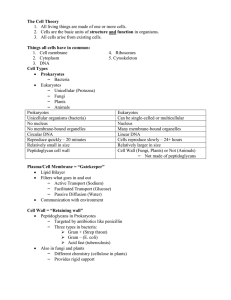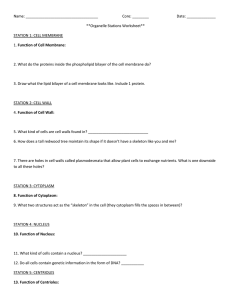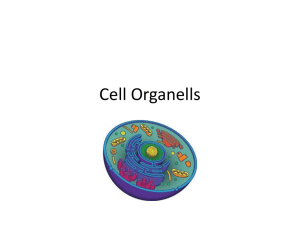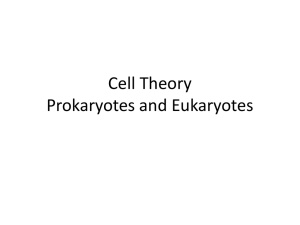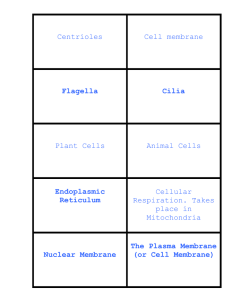Name ___________KEY______________________________________________ Period _____ The Cell Theory
advertisement
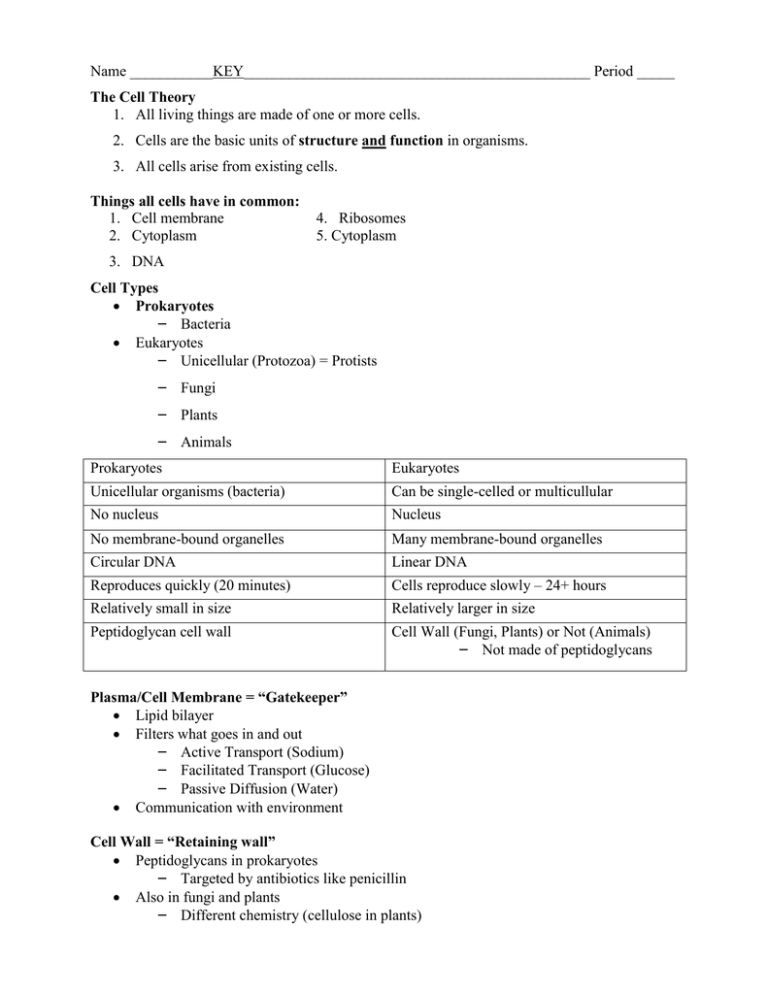
Name ___________KEY______________________________________________ Period _____ The Cell Theory 1. All living things are made of one or more cells. 2. Cells are the basic units of structure and function in organisms. 3. All cells arise from existing cells. Things all cells have in common: 1. Cell membrane 2. Cytoplasm 4. Ribosomes 5. Cytoplasm 3. DNA Cell Types Prokaryotes – Bacteria Eukaryotes – Unicellular (Protozoa) = Protists – Fungi – Plants – Animals Prokaryotes Eukaryotes Unicellular organisms (bacteria) Can be single-celled or multicullular No nucleus Nucleus No membrane-bound organelles Many membrane-bound organelles Circular DNA Linear DNA Reproduces quickly (20 minutes) Cells reproduce slowly – 24+ hours Relatively small in size Relatively larger in size Peptidoglycan cell wall Cell Wall (Fungi, Plants) or Not (Animals) – Not made of peptidoglycans Plasma/Cell Membrane = “Gatekeeper” Lipid bilayer Filters what goes in and out – Active Transport (Sodium) – Facilitated Transport (Glucose) – Passive Diffusion (Water) Communication with environment Cell Wall = “Retaining wall” Peptidoglycans in prokaryotes – Targeted by antibiotics like penicillin Also in fungi and plants – Different chemistry (cellulose in plants) – Provides rigid support Nucleus = “Brain of the cell” Consists of: – Nuclear membrane – Chromatin (DNA + proteins) – Nucleolus (rRNA ribosomes) DNA replication and transcription occurs in the nucleus Controls all cell activities. Centrioles = “Construction Foremen” Found only in animal cells (US!) Directs construction of the spindle during cell division Composed of 9 triplets of microtubules arranged in a circle. Come in pairs Mitochondria = “Powerhouse of the Cell” ATP (energy) production occurs here All mitochondria come from mother Contain own enzymes and DNA Inner and Outer membrane space with cristae in between May have originally been a “captured” bacterium put to use by cell Ribosomes = “Factories of the Cell” Found free in cytoplasm or attached to ER Translates mRNA (from DNA) into protein Two subunits – 50S and 30S 70S in prokaryotes – 60S and 40S 80S in eukaryotes – Made up of proteins and rRNA Not a true organelle (found in prokaryotes) Endoplasmic Reticulum (ER) = “Highways of the Cell” Rough (with ribosomes) – Membrane protein synthesis – Transport and vesicle formation Smooth (no ribosomes) – Synthesis and metabolism of lipids – Detoxification (lots in liver cells) Golgi Apparatus = “UPS for the Cell” Processes, Packages, and Distributes – Processing of proteins to final form – Packaging into vesicles – Distribution of vesicles to final destinations (secretion, membranes, etc.) Lysosomes and Peroxisomes = “Garbage Disposal of the Cell” Lysosomes – Highly acidic – Have pH sensitive enzymes that break down proteins and lipids Peroxisomes – Produce and metabolize H2O2 – May impact aging? (get/leak more as you age) Vesicles = “Transport Bins of Cell” Bud off of and merge with membranes Endocytosis – forms vesicle carrying substance into the cell Exocytosis – vesicle carries (secretes) substance out of the cell Cytoskeleton = “Skeleton and motion of cell” Three basic types: – Microtubules – Actin filaments – Intermediate filaments Centrosomes serve as microtubule organizing center – In animals, the centrosome has two centrioles, which play role in cell division forming the mitotic spindle Cytosol (cytoplasm) =“Soup of the Cell” Made up of water, ions, and macromolecules of the cell Organelles float within cytosol Many reactions and signaling cascades take place within the cytosol Chloroplasts =“Solar Cells of Plants” Synthesize Sugar from Sunlight (Photosynthesis) Stacked grana and thylakoid membranes filled with chlorophyll (green pigment) Energy stored via the Calvin (Dark) Cycle using carbon dioxide to form sugar Vacuoles = “Water Tower in Plants” Small in animals; used for storage One large central vacuole in plants Membrane surrounds water or other storage materials Also supplies “turgor pressure” against cell wall of plants to allow them to stand up provide structural strength If depleted, plants wilt Plant Cells vs. Animal Cells Plant Cells Animal Cells Have a cell wall Do not have a cell wall Have chloroplasts Do not have chloroplasts Large central vacuole Many small vacuoles No centrioles Pair of centrioles
